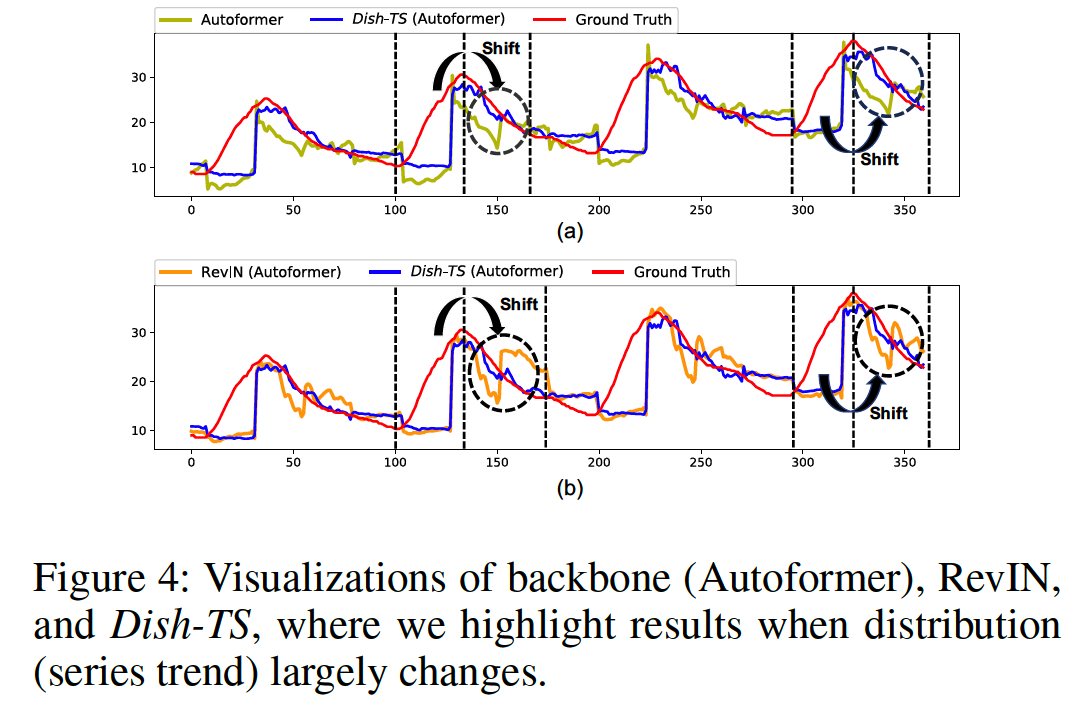Dish-TS: A General Paradigim for Alleviating Distribution for Time Series Forecasting (AAAI 2023)
https://arxiv.org/pdf/2302.14829.pdf
https://github.com/weifantt/Dish-TS.
Contents
- Abstract
- Introduction
- 2 limitations of previous works
- Dish_TS
- Related Work
- Models for TSF
- Distribution Shift in TSF
- Problem Formulations
- TSF
- Distribution Shift in TS
- Dish-TS
- Overview
- Dual-Conet Framework
- A Simple and Intuitive Instance of Conet
- Experiment
- Experimental Setup
- Overall Performance
- Comparison with Normalization Methods
- Parameters and Model Analysis
Abstract
Problems of existing works towards distribution shift
- mostly limited in the quantification of distribution
- overlook the potential shift between lookback & horizon windows
Distribution shift in TSF into 2 categories
- INTRA-space shift : input space
- INTER-space shift : input space & outpt space
Dish-TS
-
general neural paradigm for alleviating distribution shift in TSF
-
propose the coefficient net (CONET)
-
as a Dual-CONET framework
-
\(\rightarrow\) to separately learn the distribution of input- and output-space
( = captures the distribution difference of two spaces 0
-
1. Introduction
(1) 2 limitations of previous works
- Distribution quantification for intra-space in TSF is unreliable
- the empirical statistics are unreliable & limited in expressiveness for representing the true distribution behind the data
- ex) differ by sampling frequency ( fig 1(b) )
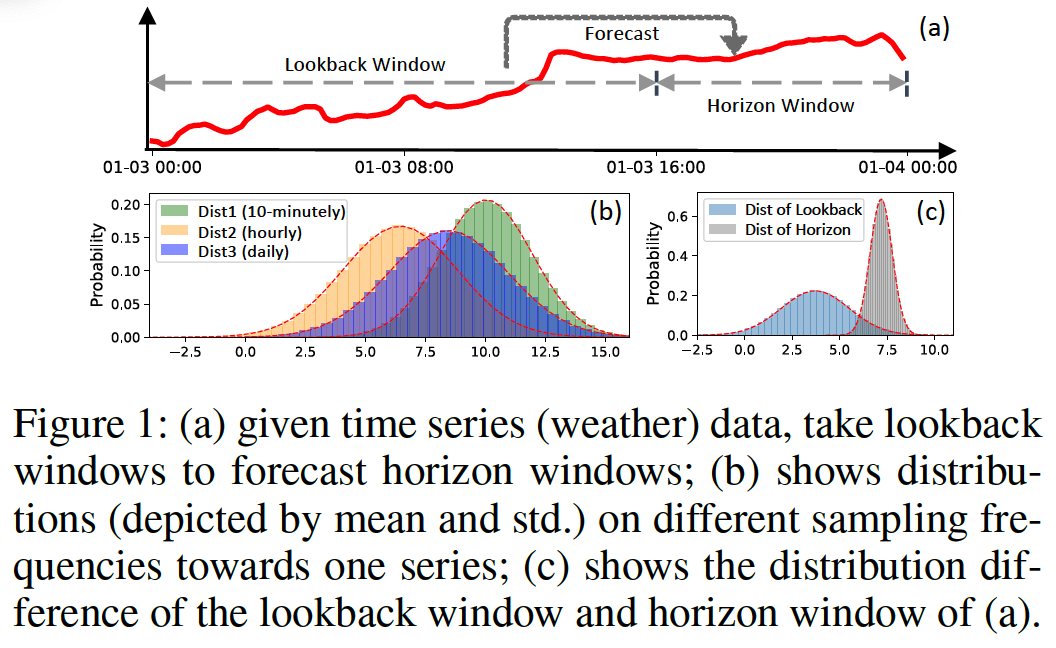
- Inter-space shift of TSF is neglected
- (preivous works) assume the input-space and output-space follow the same distribution
- RevIN??
- still limitation … strong assumption that the lookbacks and horizons share the same statistical properties ( = same distn )
- ex) ( fig 1(c) )
(2) Dish-TS
Dish-TS ( Distribution shift in Time Series )
- model-agnostic
- inspired by RevIN ( normalize & denormalize )
Problem 1) unreliable distribution quantification
Solution 1) coefficient net (CONET)
-
to measure the series distribution.
- given any window of series data, maps it into two learnable coefficients
- (1) level coefficient
- (2) scaling coefficient
- can be designed as any NN
Problem 2) intra-space shift & inter-space shift
Solution 2) as a DUAL-CONET
- consists of 2 separate CONETS
- (1) BackCONET
- coef for INPUT-space ( = lookbacks )
- (2) HoriCONET
- Chef for OUTPUT-space ( = horizons )
- (1) BackCONET
-
distinct distributions for input- and output-space
\(\rightarrow\) relieves the inter-space shift
2. Related Work
(1) Models for TSF
- pass
(2) Distribution Shift in TSF
Realworld series is changing over time (Akay and Atak 2007)
Adaptive Norm (Ogasawara et al. 2010)
- puts z-score normalization on series by the computed global statistics.
DAIN (Passalis et al. 2019)
- applies NN to adaptively normalize the series.
Adaptive RNNs (Du et al. 2021)
RevIN (Kim et al. 2022)
- instance normalization
Problem 1. ( Except for DAIN .. ) most works still used static statistics or distance function
\(\rightarrow\) limited in expressiveness.
Problem 2. Hardly consider the inter-space shift
- between model input-space and output-space.
3. Problem Formulations
(1) TSF
Notation
- \(x_t\) : value at time-step \(t\)
- input : \(\boldsymbol{x}_{t-L: t}=\left[x_{t-L+1}, \cdots, x_t\right]\)
- output : \(\boldsymbol{x}_{t: t+H}=\left[x_{t+1}, \cdots, x_{t+H}\right]\)
- \(L\) : the length of lookback windows
- \(H\) : the length of horizon windows
- \(N\) multivariate time series : \(\left\{x_t^{(1)}, x_t^{(2)}, \cdots, x_t^{(N)}\right\}_{t=1}^T\)
- MTSF task : \(\left(\boldsymbol{x}_{t: t+H}^{(1)}, \cdots, \boldsymbol{x}_{t: t+H}^{(N)}\right)^T=\mathscr{F}_{\Theta}\left(\left(\boldsymbol{x}_{t-L: t}^{(1)}, \cdots, \boldsymbol{x}_{t-L: t}^{(N)}\right)^T\right)\)
- mapping function \(\mathscr{F}_{\Theta}: \mathbb{R}^{L \times N} \rightarrow \mathbb{R}^{H \times N}\)
(2) Distn shift in TS
a) Intra-space shift
- for any time-step \(u \neq v\), \(\mid d\left(\mathcal{X}_{\text {input }}^{(i)}(u), \mathcal{X}_{\text {input }}^{(i)}(v)\right) \mid >\delta\)
- \(\delta\) is a small threshold
- \(d\) is a distance function (e.g., KL divergence)
- \(\mathcal{X}_{\text {input }}^{(i)}(u)\) and \(\mathcal{X}_{\text {input }}^{(i)}(v)\) : distributions
Most existing works:
- mention distribution shift in series, they mean our called intra-space shift
b) Inter-space shift
- \(\mid d\left(\mathcal{X}_{\text {input }}^{(i)}(u), \mathcal{X}_{\text {output }}^{(i)}(u)\right) \mid >\delta\).
( mostly ignored by current TSF models )
4. Dish-TS
(1) Overview
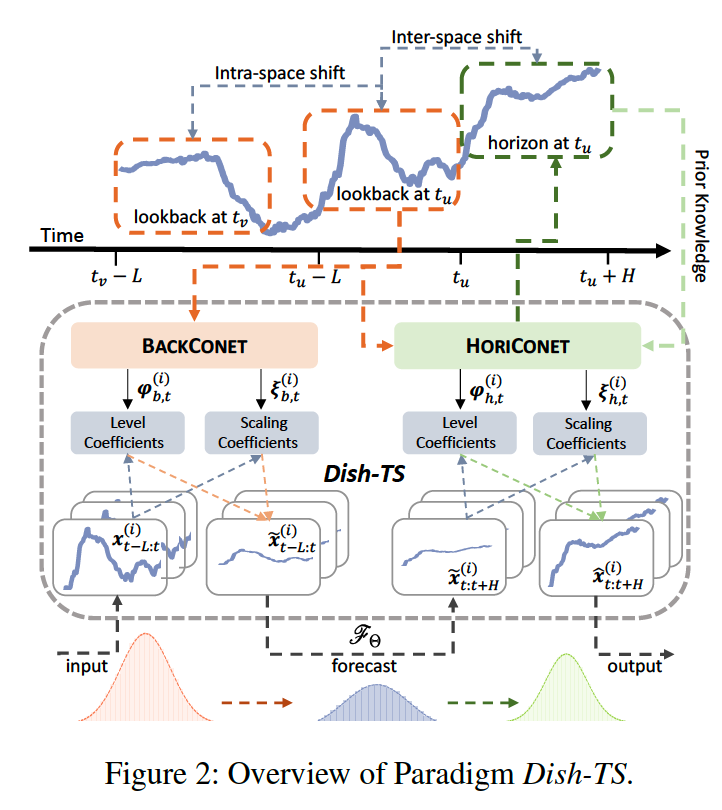
Dual CONET
- transform INPUT
- via coef obtained from BACKCONET
- transform OUTPUT
- via coef obtained from HORICONET
- becomes the forecasting output
(2) Dual-Conet Framework
illustrate how forecasting models are integrated into DualCONET
- by a two-stage normalize-denormalize process.
a) Conet (coefficient net )
\(\boldsymbol{\varphi}, \boldsymbol{\xi}=\operatorname{CONeT}(\boldsymbol{x})\).
- \(\varphi \in \mathbb{R}^1\) : level coefficient
- overall scale of input series in a window \(\boldsymbol{x} \in \mathbb{R}^L\)
- \(\boldsymbol{\xi} \in \mathbb{R}^1\) : scaling coefficient
- fluctuation scale of \(\boldsymbol{x}\).
b) Dual-Conet
Goal: to deal with intra-space shift and inter-space shift
\(\begin{aligned} & \boldsymbol{\varphi}_{b, t}^{(i)}, \boldsymbol{\xi}_{b, t}^{(i)}=\operatorname{BACKCONET}\left(\boldsymbol{x}_{t-L: t}^{(i)}\right), i=1, \cdots, N \\ & \boldsymbol{\varphi}_{h, t}^{(i)}, \boldsymbol{\xi}_{h, t}^{(i)}=\operatorname{HoRiCONET}\left(\boldsymbol{x}_{t-L: t}^{(i)}\right), i=1, \cdots, N \end{aligned}\),
- \(\boldsymbol{\varphi}_{b, t}^{(i)}, \boldsymbol{\xi}_{b, t}^{(i)} \in \mathbb{R}^1\) : coefficients for lookbacks
- \(\boldsymbol{\varphi}_{h, t}^{(i)}, \boldsymbol{\xi}_{h, t}^{(i)} \in \mathbb{R}^1\) : coefficients for horizons
\(\rightarrow\) share the same input \(\boldsymbol{x}_{t-L: t}^{(i)}\),
BACKCONET
- aims to approximate distribution \(\mathcal{X}_{\text {input }}^{(i)}\)
HORICONET
- aims to infer (or predict) future distribution \(\mathcal{X}_{\text {output }}^{(i)}\)
c) Integrating Dual-Conet into Forecasting
After acquiring coefficients from Dual-CONET…
\(\rightarrow\) the coefficients can be integrated into any TS
- through a two-stage normalizing-denormalizing process
original forecasting process \(\hat{\boldsymbol{x}}_{t: t+H}^{(i)}=\mathscr{F}_{\Theta}\left(\boldsymbol{x}_{t-L: t}^{(i)}\right)\) is rewritten as:
- \(\hat{\boldsymbol{x}}_{t: t+H}^{(i)}=\boldsymbol{\xi}_{h, t}^{(i)} \mathscr{F}_{\Theta}\left(\frac{1}{\boldsymbol{\xi}_{b, t}^{(i)}}\left(\boldsymbol{x}_{t-L: t}^{(i)}-\boldsymbol{\varphi}_{b, t}^{(i)}\right)\right)+\boldsymbol{\varphi}_{h, t}^{(i)}\).
(3) A Simple and Intuitive Instance of Conet
Flexibility of Dish-TS comes from the specific CONET design
- which could be any neural architectures for different modeling capacity.
Most intuitive way : FC layer
- Input : multivariate input \(\left\{\boldsymbol{x}_{t-L: t}^{(i)}\right\}_{i=1}^N\),
- FC layer : \(\mathbf{v}_b^{\ell}, \mathbf{v}_h^{\ell} \in \mathbb{R}^{L * N}\)
- ( consider \(\ell=1\) for simplicity )
- \(\boldsymbol{\varphi}_{b, t}^{(i)}=\sigma\left(\sum_{\tau=1}^{\operatorname{dim}\left(\mathbf{v}_{b, i}^{\ell}\right)} \mathbf{v}_{b, i \tau}^{\ell} x_{\tau-L+t}^{(i)}\right)\).
- \(\varphi_{h, t}^{(i)}=\sigma\left(\sum_{\tau=1}^{\operatorname{dim}\left(\mathbf{v}_{h, i}^{\ell}\right)} \mathbf{v}_{h, i \tau}^{\ell} x_{\tau-L+t}^{(i)}\right)\).
- \(\sigma\) : leaky ReLU
Scaling coefficients:
-
\(\boldsymbol{\xi}_{b, t}^{(i)}=\sqrt{\mathbb{E}\left(x_t^{(i)}-\boldsymbol{\varphi}_{b, t}^{(i)}\right)^2}\).
-
\(\boldsymbol{\xi}_{h, t}^{(i)}=\sqrt{\mathbb{E}\left(x_t^{(i)}-\varphi_{h, t}^{(i)}\right)^2}\).
- can be seen as the average deviation of \(\boldsymbol{x}_{t-L: t}^{(i)}\) with regard to \(\boldsymbol{\varphi}_{b, t}^{(i)}\) and \(\boldsymbol{\varphi}_{h, t}^{(i)}\).
5. Experiment
(1) Experimental Setup
a) Dataset
- Electricity
- ETT (ETTh1, ETTm2)
- Weather
- Illness
b) Evaluation
without data normalization or scaling
-
evaluations are on original data
\(\rightarrow\) thus the reported metrics are scaled for readability.
c) Implementation
- lookback length = horizon length
- except for Illness) from 24 to 336
d) Baselines
3 SOTA models
- Informer
- Autoformer
- N-Beats
(2) Overall Performance
a) UTS forecasting
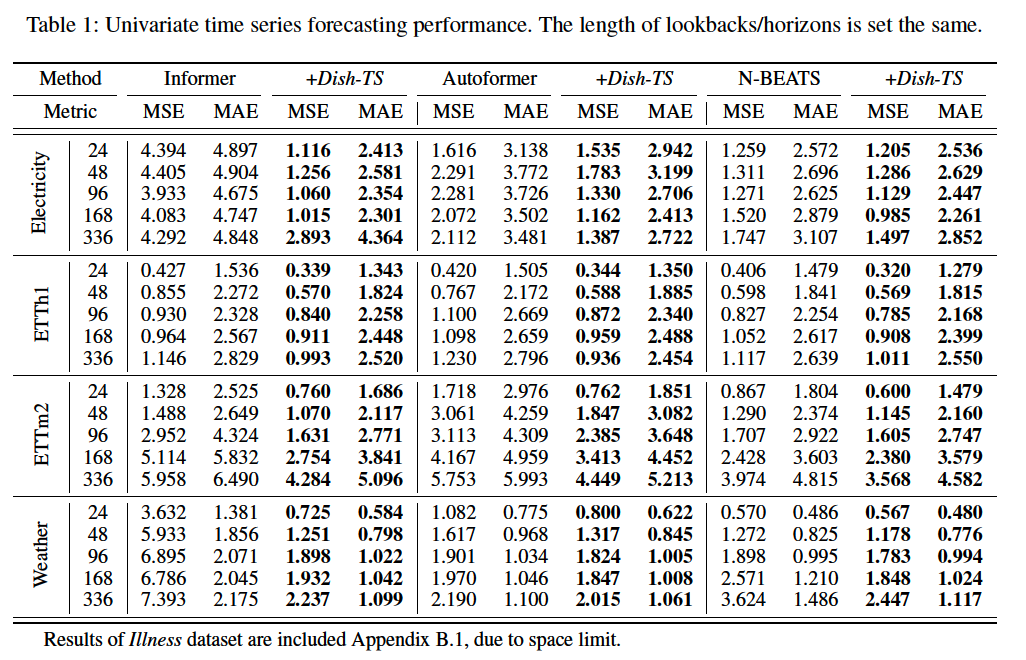
b) MTS forecasting
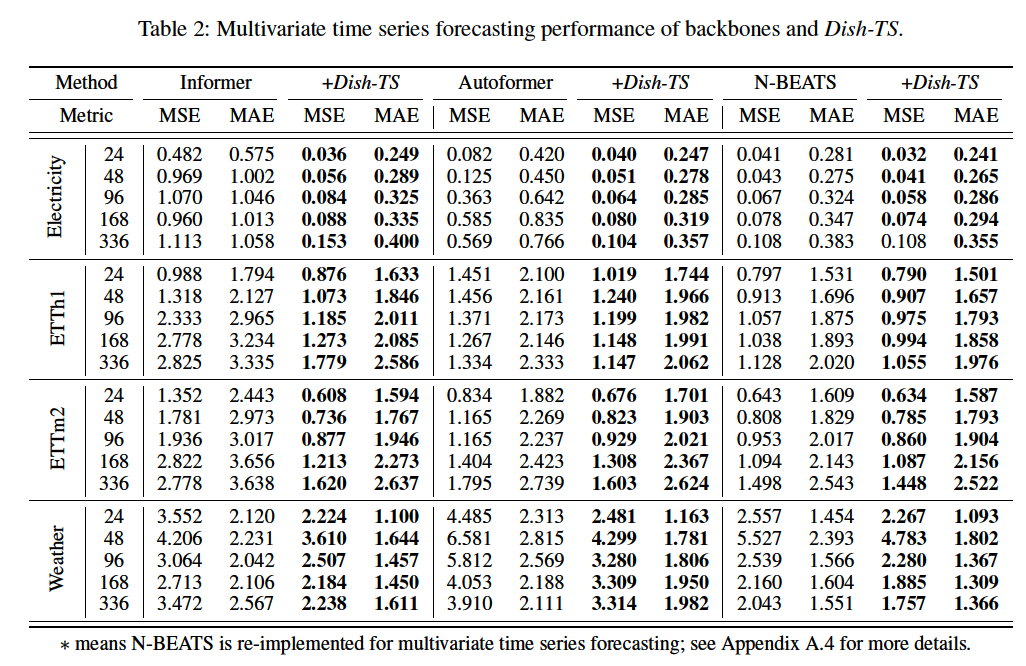
(3) Comparison with Normalization Methods
compare with RevIN (Kim et al. 2022)
( don’t consider AdaRNN (Du et al. 2021), because it is not compatible for fair comparisons )

A potential reason ?
\(\rightarrow\) consideration towards both intra-space shift and inter-space shift.
(4) Parameters and Model Analysis
a) Horizon (\(H\)) Analysis
Effect of using larger horizons ( = LTSF )
- fix \(L = 96\)
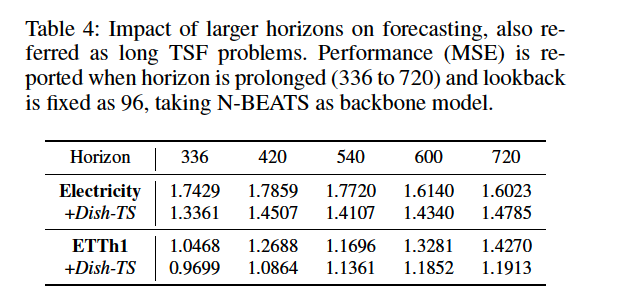
b) Lookback (\(L\)) Analysis
Effect of using larger input length
- fix \(H = 48\)
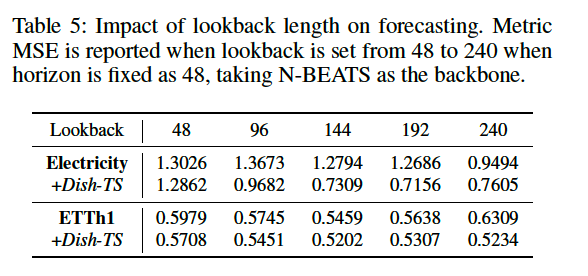
c) Conet Initialization
Initialization for FC layer : \(\mathbf{v}_b^{\ell}, \mathbf{v}_h^{\ell} \in \mathbb{R}^{L * N}\)
avg: 1norm: \(N(0,1)\)uniform: \(U(0,1)\)
Result: do not use norm !
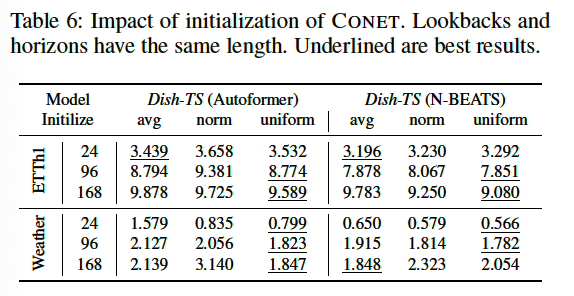
d) Visualizations
